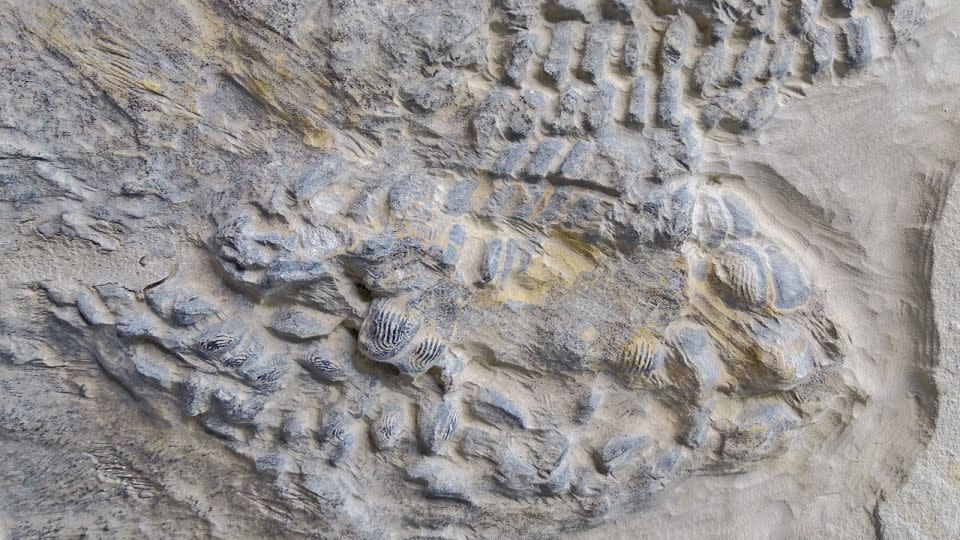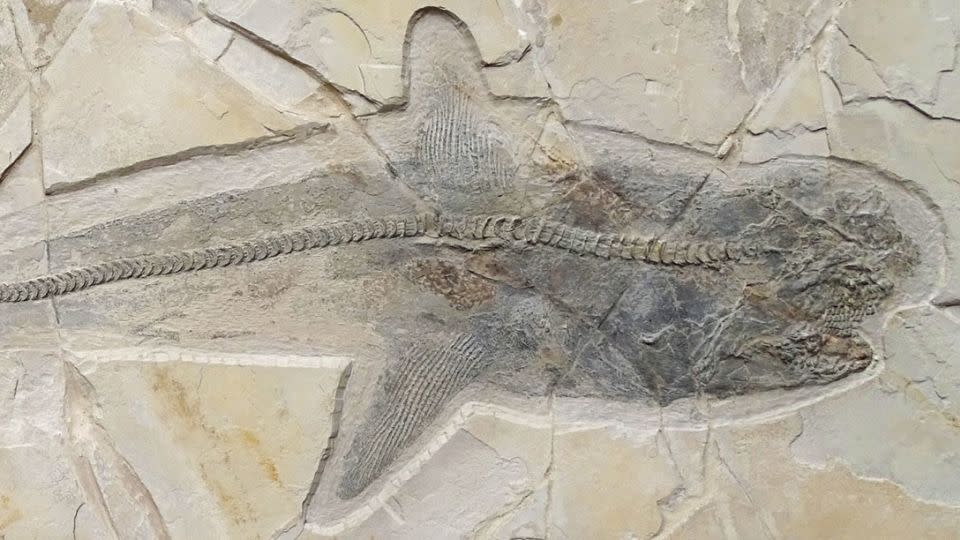Fossil of an ancient shark that swam in the age of dinosaurs solves centuries-long mystery
Sign up for CNN’s Wonder Theory science newsletter. Explore the universe with news on fascinating discoveries, scientific advancements and more.
During the Cretaceous Period, a genus of sharks roamed the sea with rows of unusual teeth. Mostly large and rounded, these chompers were not meant to slice through their prey, but to grind and crush shelled creatures.
However, since the sharks’ presence in the fossil record has mostly consisted of isolated teeth, scientists have been left to speculate on what the rest of this ancient predator looked like since its discovery in the 18th century.
Now, remains uncovered from limestone quarries in northeastern Mexico are finally giving researchers a clearer idea of the shark’s appearance, including one fossil that shows almost all skeletal elements and an outline of the specimen’s soft-tissue body. The find also reveals where the genus, known as Ptychodus, sat on the shark evolutionary tree, and other previously unknown traits of this “long-standing enigma,” according to a study published in April in the journal Proceedings of the Royal Society B: Biological Sciences.
“The finding of the skeletal remains in Mexico not only allow us to unite these teeth that have been searching for a long time for a skeleton, but also allow us as scientists to revise our previous hypotheses regarding its biology and relationships and see what we got right and what we got wrong,” said study coauthor Dr. Eduardo Villalobos Segura, an assistant professor in the department of paleontology at the University of Vienna, Austria, in an email.
The discovery also provides insight into the evolutionary history of sharks found in our oceans today, experts say.
Ancient relative of the great white shark
Most species of Ptychodus lived between 100 and 80 million years ago during the late Cretaceous period. The deposits in which the fossils were discovered — in Nuevo León near the municipality of Vallecillo — date back to approximately 93.9 to 91.85 million years ago, Villalobos Segura said.
Because shark skeletons are made of cartilage, they do not fossilize well, typically leaving archaeologists only teeth and few skeletal remains to find. But evidence suggests the Nuevo León fossils ended up in mostly stagnant conditions that would have allowed for an oxygen-deficient zone, resulting in the preservation of the soft skeletons, Villalobos Segura said.
In the study, the researchers analyzed six fossils found at the site, including the complete specimen. Three other fossils were almost complete, and two were incomplete. With these remains, the study authors determined that Ptychodus belonged to the order of sharks known as Lamniformes, or mackerel sharks, the same group that the extinct Otodus megalodon and the modern great white shark belong to. Lamniformes also includes the modern species of megamouth, sand, goblin and basking sharks, among others.
“Present-day sharks represent just a vanishingly minimal portion of the astonishing biodiversity that occurred throughout their entire evolutionary history (spanning almost 400 million years) … studying fossil sharks is crucial to understand fully the evolutionary phenomena related to current groups,” said study coauthor Dr. Manuel Amadori, a postdoctoral researcher in the department of paleontology at the University of Vienna in Austria, in an email.
The existence of mackerel sharks with crushing teeth was unknown until now, Amadori said. “There is still much more to discover, but we can say that we have taken another important step forward in understanding the complex evolutionary history of mackerel sharks,” he added.
The outline of the body, which revealed the shark’s shape and fin location, also provides evidence that the prehistoric fish was not just a bottom-dweller as previously believed, but instead, a fast-swimming predator that might have hunted and eaten sea turtles and large ammonites instead of only eating mollusks found on the ocean floor, according to the study authors. Although the shark’s exact diet is still unknown, the researchers suggest that this revised hypothesis about what it ate could be a hint at the cause of Ptychodus’ extinction, since it puts the shark in competition with other Late Cretaceous marine predators with similar diets.
“Without a complete specimen (hard evidence), what was known about Ptychodus beyond the teeth was largely scientific guesswork,” said Michael Everhart, an adjunct curator of paleontology at the Sternberg Museum of Natural History in Hays, Kansas, and an expert on Late Cretaceous marine fossils, in an email. He was not involved in the study.
“The new specimens answer questions that go back 180+ years to the 1830s when Louis Agassiz (an early renowned scientist and paleontologist) first coined the name Ptychodus,” which means rugous or wrinkled tooth, Everhart added.
Massive shell-crushing sharks
The findings also suggested that the largest species of Ptychodus may have been slightly smaller than previously thought, reaching a maximum length of 9.7 meters (nearly 32 feet). Previous estimates of a species known as Ptychodus mortoni put it at 11.2 meters (nearly 37 feet), but the revised size is still larger than modern apex shark predators, the authors note in the study. Great whites today reach up to 6 meters (20 feet) in length.
There are modern shell-crushing species, the largest being the Zebra shark, which reaches a maximum length of a little over 3.5 meters (12 feet) — not near as gigantic as Ptychodus.
“The crushing teeth together with the gigantic size make Ptychodus a very unique shark,” Amadori said. “(In the fossil record) some teeth are massive, polygonal and almost flat, while others have strange, rounded protuberances or pointed cusps on the top surface. All these were joined together to form massive tooth plates, which this predator of the past could have used to crush almost anything it encountered.”
A new fossil revealing the complete side view of Ptychodus measured nearly 1.5 meters (about 5 feet) in length, suggesting it was from was of a much smaller shark. This could be due to the remains belonging to a younger shark, or because the Ptychodus genus included various species of different sizes, Villalobos Segura said.
According to the nonprofit Mindat.org database, there are 22 species of Ptychodus currently known. Most species and individuals of Ptychodus were likely smaller than the largest Ptychodus mortoni specimen discovered, but there could also be the possibility of larger species yet to be found, Everhart said.
Often, researchers can tell apart the different species of Ptychodus by varying features in the teeth, but the study authors were unable to identify which species of Ptychodus the six fossils studied belonged to due to the teeth being too worn down, Villalobos Segura said.

The researchers said they hope future research reveals more about the ancient shark, including its diet and its role in past marine food chains and ecosystems.
“(The April study) is a comprehensive review of some remarkably complete fossils of the strange Cretaceous shark, Ptychodus,” said Dr. Bretton Kent, an emeritus principal lecturer in the department of entomology at the University of Maryland, who has studied and lectured on the diversification of elasmobranchs (sharks and rays). He was not involved in the study.
“Our present world can act like a set of blinders, limiting the scope of possible lifestyles we can envision for extinct animals. … Modern durophagous sharks (that consume hard-shelled organisms) are demersal, feeding on or near the bottom. And their bodies are frequently small and not particularly streamlined. So a gigantic, streamlined, high speed durophage that was much larger than a modern great white shark is quite remarkable,” Kent added, in an email.
For more CNN news and newsletters create an account at CNN.com


